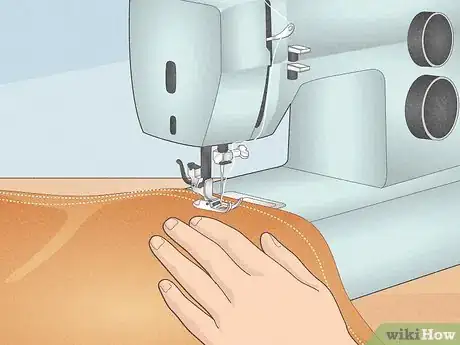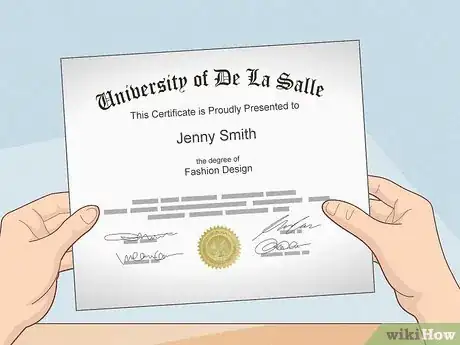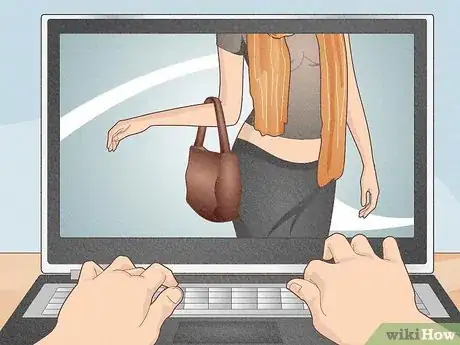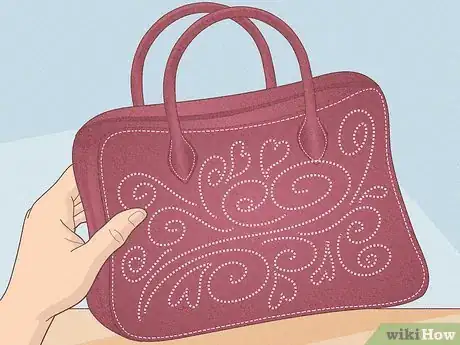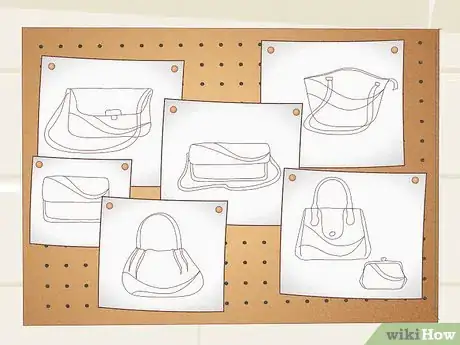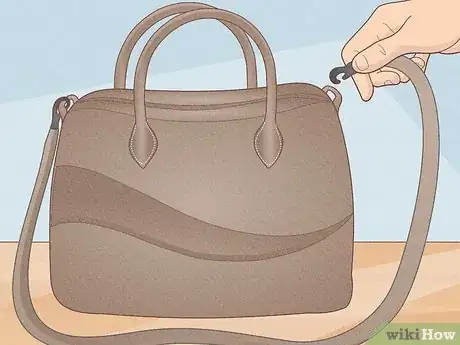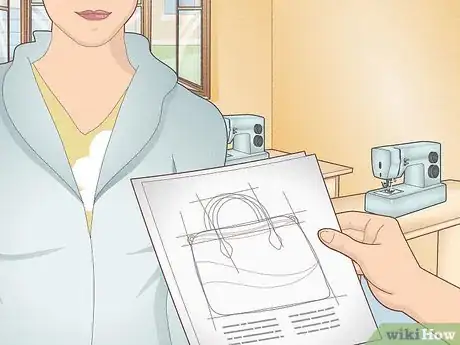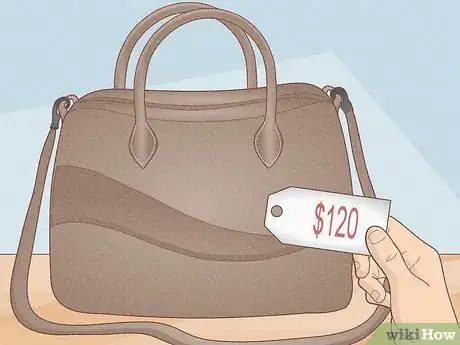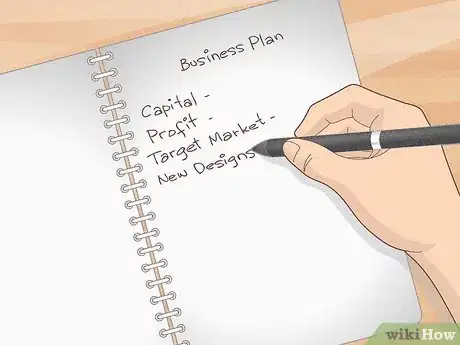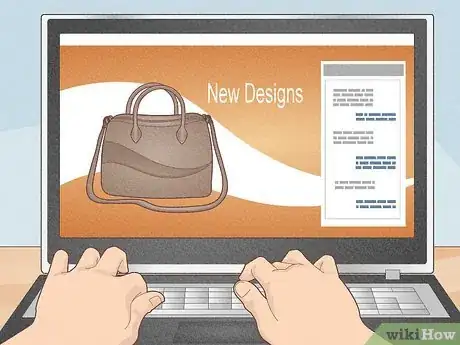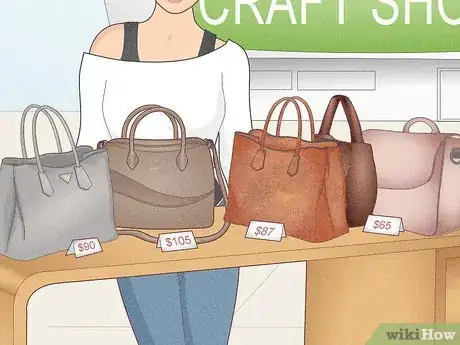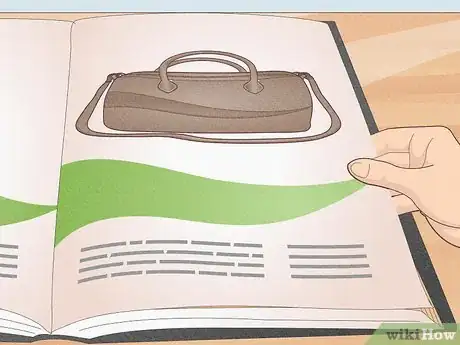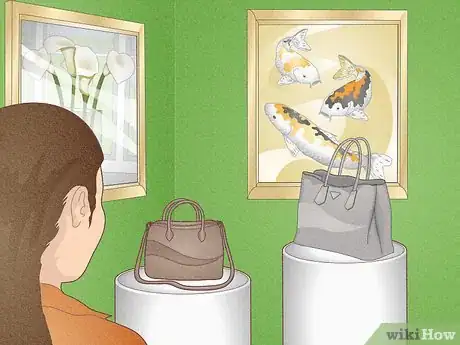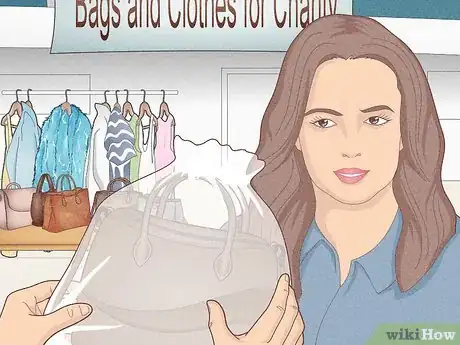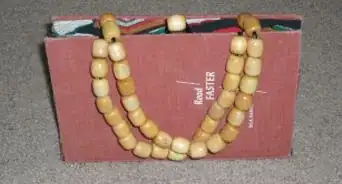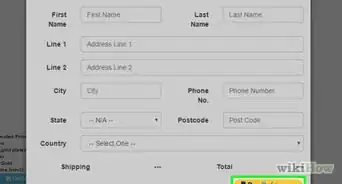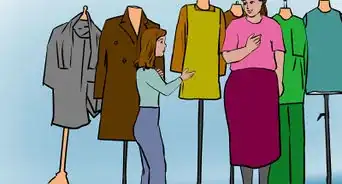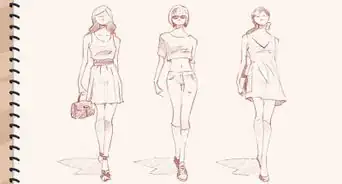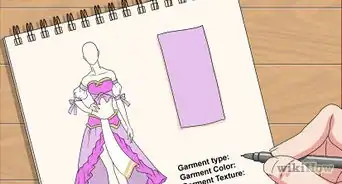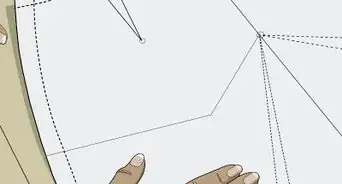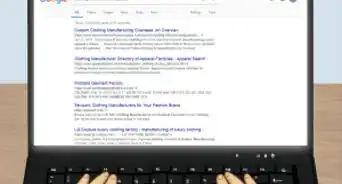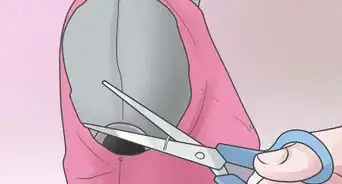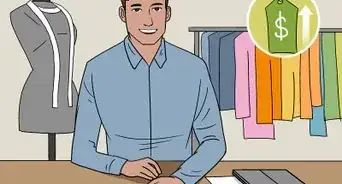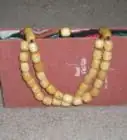This article was co-authored by Lana Blanc. Lana Blanc is a Personal and Fashion Stylist and the Founder of The Blanc House, a full-service styling company based in New York, New York. With over ten years of experience in fashion and retail, she specializes in helping others look and feel their best through activities such as editing closets and personal shopping. She has also been featured in multiple publications, including InStyle and Elle. Lana holds a BBA in International Marketing from Pace University and an MBA in Entrepreneurship and Fashion Management from LIM College.
There are 9 references cited in this article, which can be found at the bottom of the page.
wikiHow marks an article as reader-approved once it receives enough positive feedback. This article has 11 testimonials from our readers, earning it our reader-approved status.
This article has been viewed 774,069 times.
Designing handbags can be a great way to profit from your creative spirit and skills. You can design bags as a hobby or career. While it may take a while to reach your goal, you can become a successful handbag designer if you spend some time learning about fashion trends and making attractive prototypes and sample bags. If you’re down for some hard work and patience, get ready to take the fashion world by storm!
Steps
Developing Your Skills
-
1Work on your sewing and leatherworking skills. While you’re starting out, make your own bags, even if this means you need to learn how to sew. Not only will this save you money, but it’ll also help you understand all the ins and outs of the creation process. This knowledge will be crucial as you start to pick manufacturers and sources for your materials.
- Staying involved in the production process lets you be in control. What better way to make bags the way you want them to be made than to do it yourself?
- Keep expanding your skill set as you continue designing. If you’re designing cloth bags, you may want to learn how to weave. You’ll also almost certainly need to know how to sew zippers into your bags.
-
2Get a degree in fashion to make this your career. If this is going to be your main money-making job, attend a two- or four-year fashion design program at an accredited school. When you begin pitching your ideas to stores and manufacturers, this could make the difference between a “yes” and a “no” for your designs.
- These programs will teach you basic design, production, and art techniques. Some schools may also have courses in business and marketing that could be useful for you.[1]
- While you’re in the learning phase, you can also apply for internships with big-name handbag designers or other companies in the fashion industry.[2]
- Eventually, it would be helpful to find a mentor that can hopefully help guide you along your career path.
- A fashion degree doesn’t guarantee success, and it’s not necessary if it’s out of your budget. It’s even more important to be passionate about your creative and unique designs!
Advertisement -
3Research fashion trends for inspiration. As you set out on your design journey, it’s important to know what’s out there and what people like. Become an obsessive follower of fashion magazines and shows. Take note of popular colors, shapes, sizes, and styles to think about where your own bags would fit in the handbag world.[3]
- Ask your friends and family what they look for in a bag. See if they use multiple bags for different occasions.
-
4Decide what sets your bags apart. While you should have a good idea of what’s already popular, you want your stuff to be surprising. Think about what features you would most want in a handbag, and start from there. You’ll be most comfortable designing what makes you happy.[4]
- Maybe the whole reason you got into handbag design was because you couldn’t find the exact bag you wanted. If you’re struggling to find that perfect purse, you can bet other people are too.
Creating Prototypes and Samples
-
1Create a concept board and sketches to map things out. Whenever you see a picture of a bag, outfit, or something else that jumpstarts a designing brainstorm, pin it to a wall or bulletin board. Sit next to the board while you use pencil to make some rough sketches of a bag. You can then make the sketch more detailed with pen and colored pencils, or use a computer program to create a digital sketch.[5]
- Don’t underestimate the value of starting with pencil. Because pencil marks can be easily erased, this low-pressure tool will give you the freedom to draw and create without worrying about messing up.[6]
-
2Use cheaper materials for cost-effective prototypes. Prototypes are early-stage products that allow you to make changes to bags before you mass-produce and sell them. Don’t spend too much creating these “scrap” bags. Save the big spending for the product you’re ready to share with corporate buyers and your devoted customers.[7]
- This may mean using synthetic leather instead of real leather. If you’ll be sewing on jeweled or fine-metal embellishments for the final product, use fake embellishments for the prototype.
-
3Make careful revisions to perfect your bags. You’ll only be able to do some of your editing on a sketchpad. The best part about prototypes is that they let you refine a concrete product. Be critical of the bag and ask yourself how it will make customers happy, and if there’s anything that could disappoint them.[8]
- Is this a fancier bag that will get scuffed up or damaged with lots of use? Is there a way to make it sturdier? Is it comfortable to carry? Does it fit all the essentials, including a phone, a wallet, and some makeup?
-
4Find a manufacturer when you’re ready to mass-produce. Manufacturers quickly produce lots of products using your exact specifications for design and material. They’ll create both prototypes and - even more exciting - samples.
- Prototypes help you revise and fix your design, while samples get products ready for mass production. The samples allow you and the manufacturer to estimate the costs of production and pricing, to provide an example bag to give to marketers and buyers, and to have something to photograph.[9]
- Find a manufacturer by looking online. Start by searching for producers in your area, and expand your search depending on what you need from your manufacturer.
-
5Price your product carefully. You and your manufacturer will likely spend a lot of time discussing the costs of production and the best price to make a profit off your bag. While you’re having this conversation, do research online and in fashion magazines to compare your prices with those of similar bags. You don’t want your bag to be either too expensive or too cheap to appeal to your customers.[10]
-
6Launch your product when it’s complete. Contact local and big-name retailers and have your samples ready to send out. Do some online research about your potential sellers to make sure your product fits with what they currently offer to their customers.[11]
- Start with local retailers. Since you’ll be selling in your community, this lets you receive detailed feedback from customers and store owners.[12]
- Send pictures of your samples to popular online fashion blogs to drum up some excitement for your bags. Retailers want products that customers want to buy.[13]
Expanding Your Business
-
1Write a business plan to keep track of your goals. Especially when you’re starting out, you need to keep track of how much money you plan to spend, and how much you’d like to make. It’s also important for you to spend some time thinking about who your customers are and how your products will thrill and dazzle them.
-
2Create an online platform to gain customers. Once you’ve got an established line or set of products, use every possible online platform to get them out there into the world. Social media is a wonderful way to let thousands and even millions of people around the world know that you’re ready to create the perfect bag just for them.
- Make a website or write a blog documenting your entire process. People will love seeing how you’re getting started and watching your bags move from nonexistent to finished and beautiful!
- Start an online store through a website like Etsy. This already-established platform is easy to use and reliable. It can also give you some good exposure.
- Use Instagram to share great photos of finished products or the production process.
- Use Twitter and Facebook to send out fun messages to give your brand personality along with the products.
- Use LinkedIn to develop the professional side of your business. People may use LinkedIn to see if they can work with or even for you.
-
3Sell your awesome bags at craft shows and farmers’ markets. Look for a weekly market in your town or city. Especially during the summer months, these fun, outdoor exhibits are staples in most localities around the United States. These are great spots to test your your early designs.
- Starting small allows you to keep your initial costs low, since you can probably make the first several batches of bags on your own. This will let you avoid working with a manufacturer until you’re ready.[14]
- Ask people what they think about your bags when they visit your spot. Even if no one buys your stuff, craft shows are perfect for getting good, honest feedback.
-
4Create a portfolio with professional photos. Don’t let a bad photo taken on your smartphone be the reason your career as a handbag designer fails! Even though a session with a professional photographer is expensive, it’s worth the investment. Your bags deserve pictures that show them off in all their glory.
- If good photos are really out of your budget, ask your friends and family if anyone owns a nice camera. Lots of people do photography as a hobby, and close buddies may be willing to lend a hand for a free (or heavily discounted) bag.
- This goes for your website, too. Nothing makes a website look unprofessional like bad pictures.
-
5Look for PR and sales agents to represent your work. PR and sales agents help you market to more customers and get better deals from retailers. They take a percentage of your profit, so wait until you’ve got an established income from your bags to hire these folks. Do research online to find agents who represent sellers similar to you, as this means they’ve got direct experience with your specific market.
-
6Show your work at fashion shows and exhibitions. Having your work appear at fashion shows means that fellow designers, celebrities, and models will get to see your work. These extravagant affairs are highly publicized and glitzy, so they’re a perfect spot for showing off unique, new products.
- While some fashion shows may ask emerging designers to present their work, you can also pay venues to allow you to exhibit your bags.[15]
-
7Give your work to charity shows for increased exposure. Offering your bags as gifts or raffle prizes at charity events not only allows you to get involved with causes you believe in, it also introduces your work to new people. These elaborate balls and galas often attract the who’s who among the rich and famous. If a celebrity wins and wears your bag, you’ve just gotten a boatload of free publicity!
Community Q&A
-
QuestionHow can I learn how to make ladies' handbags from anywhere in the world?
 Community AnswerIf you're not in a place that has fashion design schools, go online! Use pinterest and Etsy to get ideas from other designers, and to learn how to sew and create your bags.
Community AnswerIf you're not in a place that has fashion design schools, go online! Use pinterest and Etsy to get ideas from other designers, and to learn how to sew and create your bags. -
QuestionIf I'm selling my bag online, how can I keep my business safe from credit card scammers?
 Community AnswerSet up your shop with an established online site, such as Etsy.com. These websites have lots of protections in place to ensure that you don't get scammed.
Community AnswerSet up your shop with an established online site, such as Etsy.com. These websites have lots of protections in place to ensure that you don't get scammed. -
QuestionWhat type of material can I use to make my bag firm and stand up?
 Community AnswerCraft or Home Decor fusible interfacing is easiest for beginners. Other options include crinoline, thermal mylar (like bubble wrap), vinyl, flannel backed rubber sheeting (the old fashioned stuff for baby cribs) or any other stiffener, Interfacing for dresses is lighter weight if you want a softer bag.
Community AnswerCraft or Home Decor fusible interfacing is easiest for beginners. Other options include crinoline, thermal mylar (like bubble wrap), vinyl, flannel backed rubber sheeting (the old fashioned stuff for baby cribs) or any other stiffener, Interfacing for dresses is lighter weight if you want a softer bag.
References
- ↑ http://learn.org/articles/How_Do_I_Become_a_Handbag_Designer.html
- ↑ http://learn.org/articles/How_Do_I_Become_a_Handbag_Designer.html
- ↑ https://www.linkedin.com/pulse/20140630142245-44164177-how-to-design-your-handbag-line-in-5-steps
- ↑ http://www.blackenterprise.com/small-business/how-self-taught-handbag-designer-turned-hobby-full-time-business/
- ↑ https://www.linkedin.com/pulse/20140630142245-44164177-how-to-design-your-handbag-line-in-5-steps
- ↑ http://makersrow.com/blog/2014/07/messenger-bag-process-from-sketch-to-finished-product/#
- ↑ https://www.linkedin.com/pulse/20140630142245-44164177-how-to-design-your-handbag-line-in-5-steps
- ↑ https://www.linkedin.com/pulse/20140630142245-44164177-how-to-design-your-handbag-line-in-5-steps
- ↑ http://makersrow.com/blog/2016/07/prototype-vs-sample-whats-the-difference/
- ↑ http://www.nytimes.com/2013/09/18/fashion/Sophie-Hulme-and-Her-Handbag-Niche.html
- ↑ http://makersrow.com/blog/2014/07/messenger-bag-process-from-sketch-to-finished-product/#
- ↑ http://www.nytimes.com/2010/10/21/business/smallbusiness/21sbiz.html
- ↑ http://www.nytimes.com/2010/10/21/business/smallbusiness/21sbiz.html
- ↑ https://www.entrepreneur.com/businessideas/handbag-design-and-manufacturing
- ↑ http://www.slate.com/articles/arts/fashion/2005/02/fashion_week_faq.html
About This Article
If you want to become a handbag designer, work on your sewing and leatherworking skills by making all your own bags. Additionally, read fashion magazines and try to go to fashion shows, where you can get inspiration from recent trends. Come up with something that sets your handbag designs apart, like a feature that you can’t find in store bags. You might also want to consider going to a 2- or 4-year fashion design program to learn basic design, production, and art techniques. To learn how to create prototypes and samples of the handbags you design, keep reading!
